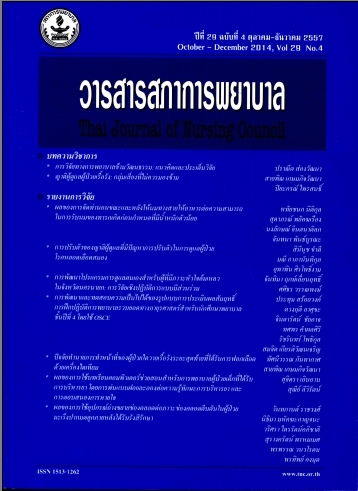การพัฒนาและทดสอบความเป็นไปได้ของรูปแบบการประเมินผลสัมฤทธิ์การฝึกปฏิบัติ การพยาบาลรวบยอดทางอายุรศาสตร์สำหรับนักศึกษาพยาบาลชั้นปีที่ 4 โดยใช้ OSCE
Keywords:
รูปแบบการประเมินผลสัมฤทธิ์ การฝึกปฏิบัติการพยาบาลรวบยอด อายุรศาสตร์ การสอบโดยใช้ OSCE, , evaluation model for medical nursing comprehensive practice, objective structure clinical examination (OSCE), nursing students’ competency Based on Thai QualificatiAbstract
บทคัดย่อ: วัตถุประสงค์การวิจัย: เพื่อพัฒนาและทดสอบความเป็นไปได้ของรูปแบบการประเมินผลสัมฤทธิ์การฝึกปฏิบัติการพยาบาลรวบยอดทางอายุรศาสตร์สำหรับนักศึกษาพยาบาลชั้นปีที่ 4 โดยใช้ OSCE เพื่อส่งเสริมสมรรถนะของนักศึกษาพยาบาลตามกรอบคุณวุฒิระดับอุดมศึกษาแห่งชาติ
การออกแบบวิจัย: การวิจัยในชั้นเรียน
การดำเนินการวิจัย: แบ่งเป็น 2 ระยะคือ ระยะที่ 1 ระยะพัฒนารูปแบบการประเมินผลสัมฤทธิ์การฝึกปฏิบัติการพยาบาลรวบยอดโดยใช้ OCSE ประกอบด้วยการจัดทำข้อสอบและการตรวจสอบคุณภาพของข้อสอบ และระยะที่ 2 ระยะนำรูปแบบการประเมินผลไปทดลองสอบในกลุ่มตัวอย่างที่เป็นนักศึกษาพยาบาลชั้นปีที่ 4 จำนวน 7 คน ประเมินผลความเป็นไปได้โดยใช้แบบประเมินความพึงพอใจและแนวคำถามการสนทนากลุ่มเกี่ยวกับการประเมินผลด้วยวิธี OSCE วิเคราะห์ข้อมูลโดยใช้ความถี่และการวิเคราะห์เนื้อหา
ผลการวิจัย: รูปแบบการประเมินโดยใช้ OSCE ประกอบด้วย 8 สถานี ๆ ละ 15 นาที ระยะเวลาสอบประมาณ 2 ชั่วโมง กลุ่มตัวอย่าง 3 คนประเมินความพึงพอใจอยู่ในระดับร้อยละ 70 ส่วนอีก 4 คนมีความพึงพอใจระดับ 80 ขึ้นไป ในการสนทนากลุ่ม นักศึกษาประเมินว่ากิจกรรมและระยะเวลาในการสอบมีความเหมาะสม สามารถประเมินทักษะด้านการปฏิบัติทางวิชาชีพและทักษะตามกรอบมาตรฐานคุณวุฒิระดับอุดมศึกษาแห่งชาติ และควรนำวิธีการสอบ OSCE นี้มาเป็นส่วนหนึ่งของการประเมินผลการฝึกปฏิบัติการพยาบาลรวบยอดทางอายุรศาสตร์
ข้อเสนอแนะ: ควรใช้รูปแบบการประเมินโดยใช้ OSCE นี้ในการประเมินผลสัมฤทธิ์การฝึกปฏิบัติการพยาบาลรวบยอดทางอายุรศาสตร์สำหรับนักศึกษาพยาบาลชั้นปีที่ 4 ตามกรอบคุณวุฒิระดับอุดมศึกษาแห่งชาติ เพื่อให้การประเมินทักษะนักศึกษามีความน่าเชื่อถือและตรงกับความสามารถของนักศึกษา รวมทั้งช่วยให้นักศึกษาได้แนวทางในการพัฒนาตนเองต่อไป
Abstract:
Objective: This pilot study aimed to develop and explore the feasibility of the evaluation model for medical nursing comprehensive practice using objective structure clinical examination (OSCE) in Senior Nursing Students to Promote Nursing Students’ Competency Based on Thai Qualifications Framework for Higher Education (TQF). Design: Classroom research
Implementation: Data were collected in two phases. Phase I, development of the evaluation model using OSCE. It included the development of questions and quality testing. Phase II, implementation to test the evaluation model with 7 senior nursing students. The feasibility of using the model through OSCE was obtained through satisfaction questionnaire and focus group discussion. Data were analyzed using frequency and content analysis.
Results: The evaluation model using OSCE consisted of 8 stations. Each station required 15 minutes to finish each scenario. The duration of an examination was 2 hours. Three students rated their satisfaction to the model at 70 percent, the other 4 students rated at higher than 80 percent. In the focus group, students expressed that the scenarios and duration spending in examination were appropriate. This model was feasible to evaluate students’ skills and competency based on TQF. This evaluation model may be used as one part of the medical nursing comprehensive practice course evaluation.
Recommendations: The evaluation model using OSCE should be used to evaluate senior nursing students in the medical nursing comprehensive practice course base on TQF. It would lead students’ competency evaluation to be reliable and valid. Thus, nursing students will have guides for self-improvement after graduation.







